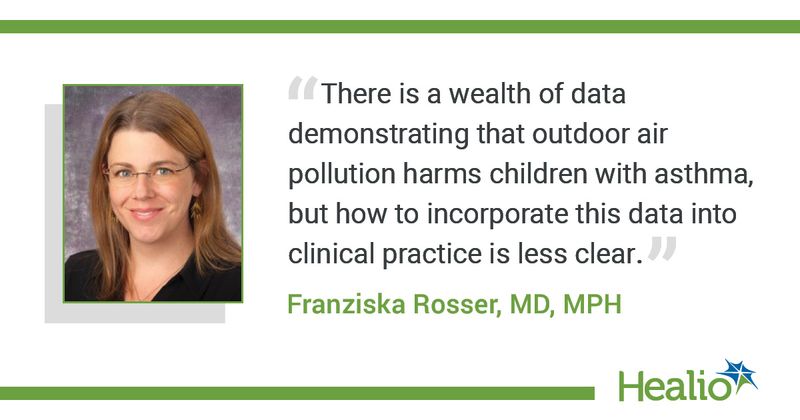Air Quality Index associated with increased odds of exacerbations in children with asthma
A new study linked the Air Quality Index with an increase in exacerbations requiring an ED visit or hospitalization among children with asthma living in Pennsylvania.
“There is a wealth of data demonstrating that outdoor air pollution harms children with asthma, but how to incorporate this data into clinical practice is less clear. Guidelines appropriately recommend that health care providers discuss outdoor air pollution, but we don’t have evidence-based guidelines about what air index we should use or a definition of ‘high’ air pollution,” Franziska Rosser, MD, MPH, assistant professor of pediatrics in the division of pulmonology at UPMC Children’s Hospital of Pittsburgh at the University of Pittsburgh, told Healio. “Many pollutants don’t have known ‘safe’ levels, and several studies in children with asthma have shown that asthma can get worse even at levels below national air standards. In the United States, the Environmental Protection Agency designed the Air Quality Index (AQI), which alerts the public to the air quality and provides recommendations of what to do when the air quality is poor.”

Rosser and colleagues aimed to evaluate the association between the AQI and asthma exacerbations in children. The retrospective, time-stratified, case-crossover study used medical records from UPMC Children’s Hospital of Pittsburgh from 2010 to 2018 for children aged 6 to 17 years with an asthma exacerbation, which was defined as an ED visit or hospitalization for asthma. Average age at the time of exacerbation was 10 years. Most children (64%) had one exacerbation event, but most events occurred in children with multiple exacerbations during the study period. Exacerbation resulted in an ED visit in more than 99% of cases. Black children had more exacerbation events compared with white children (65% vs. 31% of events). Researchers collected daily AQI data for Allegheny County, Pennsylvania.
During the study period, 6,573 events occurred. Particulate matter less than 2.5 µm (PM2.5) was the primary pollutant in 62% of days with events and ozone was the second most common pollutant in 29% of days with events.
“The link between the AQI and asthma attacks seems to be driven by fine particulate matter. PM2.5 was the pollutant responsible for the AQI on most days during our study period. We did not find an association between the AQI for ozone or nitrogen dioxide and asthma visits. As both ozone and nitrogen dioxide have been associated with worsening of asthma, more studies are needed to understand this finding in our region,” Rosser told Healio.
Each 10-unit increment in the overall AQI was associated with increased odds of asthma exacerbation on lag day 2 (OR = 1.014; 95% CI, 1.003-1.025) and lag day 3 (OR = 1.012; 95% CI, 1.001-1.023).
The researchers reported analyses stratified by age and race. AQI was also associated with increased odds of asthma exacerbation among Black children (OR = 1.016; 95% CI, 1.002-1.03; P = .02) and those aged 6 to 11 years (OR = 1.022; 95% CI, 1.003-1.041; P = .02) on lag day 4.
“Our findings suggest that children with asthma should check the AQI so that they can make changes in their outdoor activity on days when the AQI number or category is at a level that has triggered their asthma in the past. When discussing the AQI, it is really important to remember that the best and most equitable way to reduce harm is to adopt policies that reduce outdoor pollution,” Rosser said.
The researchers said further research is needed.
“In order to provide evidence-based recommendations during clinical encounters, prospective, multicenter studies in children with asthma are needed to determine if checking the AQI via AirNow.gov prior to outdoor activities can prevent asthma attacks,” Rosser told Healio.
For more information:
Franziska Rosser, MD, MPH, can be reached at franziska.rosser2@chp.edu.
